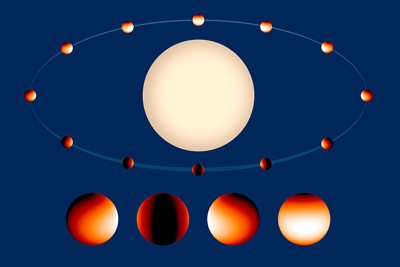A team of scientists using NASA's Hubble Space Telescope have made the most detailed global map yet of the glow from a planet orbiting another star, revealing secrets of air temperatures and water.
The map provides information about temperatures at different layers of the world's atmosphere and traces the amount and distribution of water vapor on the planet. The findings have ramifications for the understanding of atmospheric dynamics and the formation of giant planets like Jupiter.
"Water is thought to play an important role in the formation of giant planets, since comet-like bodies bombard young planets, delivering most of the water and other molecules that we can observe," said Jonathan Fortney, professor of astronomy and astrophysics at UC Santa Cruz and a member of the team.
Fortney and postdoctoral researcher Mike Line did most of the theoretical work and modeling of the planet's atmosphere presented in two new papers, one published online in Science on October 2 and the other published in Astrophysical Journal Letters on September 12.
"These measurements have opened the door for a new kind of comparative planetology," said team leader Jacob Bean of the University of Chicago.
The Hubble observations show that the planet, called WASP-43b, is no place to call home. It's a world of extremes, where seething winds howl at the speed of sound from a 3,000-degree-Fahrenheit day side that is hot enough to melt steel to a pitch-black night side that sees temperatures plunge below a relatively cool 1,000 degrees Fahrenheit.
As a hot ball of predominantly hydrogen gas, there are no surface features on the planet, such as oceans or continents that can be used to track its rotation. Only the severe temperature difference between the day and night sides can be used by a remote observer to mark the passage of a day on this world.
"Our observations are the first of their kind in terms of providing a two-dimensional map of the planet's thermal structure that can be used to constrain atmospheric circulation and dynamical models for hot exoplanets," added team member Kevin Stevenson of the University of Chicago.
WASP-43b is located 260 light-years away and was first discovered in 2011. WASP-43b is too distant to be photographed, but because its orbit is observed edge-on to Earth, astronomers detected it by observing regular dips in the light of its parent star as the planet passes in front of it.
The planet is about the same size as Jupiter, but is nearly twice as massive. The planet is so close to its orange dwarf host star that it completes an orbit in just 19 hours. The planet is also gravitationally locked so that it keeps one hemisphere facing the star, just as our moon keeps one face toward Earth.
The scientists combined two previous methods of analyzing exoplanets and put them together in one for the first time to study the atmosphere of WASP-43b. Spectroscopy allowed them to determine the water abundance and temperature structure of the atmosphere. By observing the planet's rotation, the astronomers were also able to measure the water abundances and temperatures at different longitudes.
Because there's no planet with these tortured conditions in our solar system, characterizing the atmosphere of such a bizarre world provides a unique laboratory for better understanding planet formation and planetary physics. "The planet is so hot that all the water in its atmosphere is vaporized, rather than condensed into icy clouds like on Jupiter," said team member Laura Kreidberg of the University of Chicago.
The water abundances in the giant planets of our solar system are poorly known because water is locked away as ice that has precipitated out of their upper atmospheres. But on "hot Jupiters" — that is, large planets like Jupiter that have high surface temperatures because they orbit very close to their stars — water is in a vapor that can be readily traced. Kreidberg also emphasized that the team didn't simply detect water in the atmosphere of WASP-43b, but also precisely measured how much of it there is and how it is distributed with longitude.
In order to understand how giant planets form, astronomers want to know how enriched they are in different elements. The team found that WASP-43b has about the same amount of water as we would expect for an object with the same chemical composition as the Sun. Kreidberg said that this tells something fundamental about how the planet formed.
For the first time astronomers were able to observe three complete rotations of a planet, which occurred during a span of four days. This was essential to making such a precise measurement according to Jean-Michel Désert of the University of Colorado, Boulder.
The team next aims to make water-abundance measurements for different planets to explore their chemical abundances. Hubble's planned successor, the James Webb Space Telescope, will be able to not only measure water abundances, but also the abundances of carbon monoxide, carbon dioxide, ammonia, and methane, depending on the planet's temperature.



